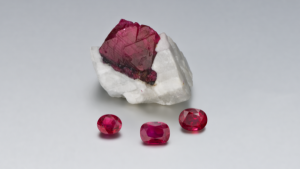Carla’s fiancé came in for a surprise engagement ring. He wanted a Ruby solitaire and he knew Carla liked yellow gold. He also mentioned that Carla loves flowers, specially Tulips. Based on Carla’s images and her hand shape, I suggested a ring that’s simple at a glance yet has an element of complication. I sketched a few ideas..I wanted something innovative because Carla and her fiancé are both scientists and I also wanted it to be romantic based on what I saw from Carla’s images. So I came up with the idea that the top view of the ring would be clean and the element of complication would be on the sides of the ring and how the ruby was set. I made the sides of the ring angled and put flower petals in an angle rising up and gently coming out of the sides and reaching to the top of the band forming a frame from top view. An innovative concept where the side of the ring becomes part of the top view of the ring — inspired by Carla’s love for flowers. The beautiful ruby is also set in a frame of petals that complement the side flows.
I also wanted to thank Boston Magazine for featuring this ring in their 2016 Volume II issue of Boston Magazine’s Wedding issue.
Here’s a quick information on Rubies:
Ruby is July’s birthstone. It is made out of two elements, its main element is corundum and has traces of chromium. Corundum is usually colorless, but once chromium joins it’s crystal structure it creates the rich red colors that rubies are sought after for. Ruby calls for the highest per carat price of any colored gemstone.
Ruby is mined all over the world, while the most sought after rubies are mined in Burma, they are also mined in Madagascar, Sri Lanka, Vietnam, and many other countries. When it comes to factors that effect the value of rubies, color is one of the factors that has the biggest impact. The colors of rubies range from orangey red to purplish red. The deeper the red of the gemstone, the higher price per carat the stone will command.
While an untreated deep red is the most sought after kind of ruby, most of the rubies on the market today are heat treated or treated in some way. Heat treating is the most common treatment and it is the process of heating the stone to high temperatures to improve the gemstones color or clarity. Heat treating can be used to remove a brownish hue from the stone, to deepen the red color or to remove inclusions like clouds of silk from the stone.
Thank you,
Cynthia










